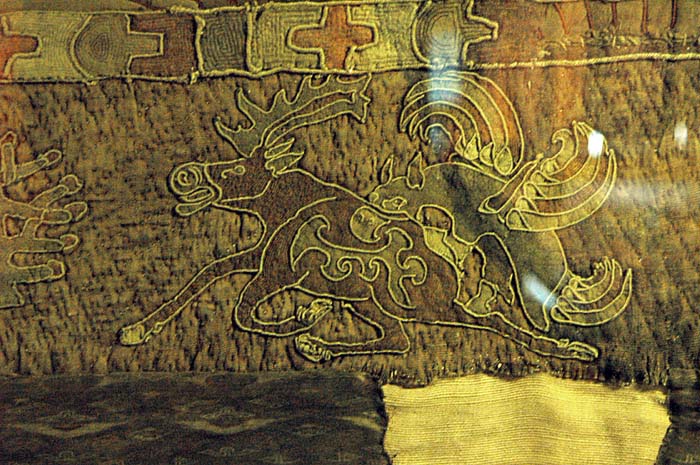A walled settlement of the Xiongnu period, located in a place named Baruun Duruu, in distances of 7 km in the east of the Bars Hot-I and of 5 km from the Kherulen River, Tsagaan Ovoo Soum, Dornod aimag. This wall was first discovered by Kh. Perlee in 1951 and has been explored and partially excavated then. The rampart was built with hardened earth. The dimension of the wall is in the length of 345 m in the north, 335 m in the west, 345 m in the south, and 335 m in the east. And now it is 1-2 m in height and 4-5 m in width. In the north part of the wall, there are four earthen mounts apparently the rest from the construction. A small area, on both sides of the earthen mound, has been excavated. Some little fragments of charcoal, a fraction of rotted wood in the sites as well as pottery were found 1.25 m in depth from the east mound respectively. As this pottery is quite similar to when found from the grave of the Noyon Uul, this wall has been determined to date to the Xiongnu period.
Baruun Khairkhan tombs
Xiongnu period cemetery of common people in Mongolia. The site is located in the Songino mountain which lies close to the north bank of the Tuul River, at a distance of 30 km in the west of Ulaanbaatar, Altanbulag soum, Tuv aimag. The western part of this mountain is named Baruun Khairkhan. This mountain has kept some square graves and ten Xiongnu graves, put close to each other, on its southern lower slope. The Xiongnu graves in the Baruun Khairkhan were discovered by an expedition for the Bronze and Iron Age research team in 1982, and four of them were excavated in the same year. Afterward, an expedition for Xiongnu studies excavated and researched two graves in 1990. An iron sword is found in one of the Xiongnu burials.
Batbold Natsag
Mongolian archeologist. Research fellow of the Department of Xiongnu Archeology, Institute of Archeology, MAS, Ph.D. Born in 1968 in Bugant khoroo of Selenge province. In 2000, graduated from Ulaanbaatar State University with a major in history and archeology. In 2003, he received a master’s degree with his work “Some issues of the Xiongnu funeral ritual”. In 2001, he defeated a Ph.D. with his dissertation “Rock Art Study of Mongolia (according to the research materials of the Gobi region)”.
N.Batbold conducts studies on the ancient history of Mongolia, especially on the petroglyphs of the Bronze Age and the Xiongnu period. He wrote 11 joint scientific reports and is a co-author of monographs, including “Petroglyphs of Biluu at Del Uul, Dundgovi province” (UB,. 2005), “Petroglyphs of Shaakhar Tolgoi” (UB., 2008), “Xiongnu burial sites in Mongolia” (UB-Seoul, 2010), and wrote over 20 articles and papers, which published in domestic and foreign (USA, Japan, South Korea) scientific reviews. In 1999, 2003, and 2005 he participated in the “Nomadic Empire” project, and since 2006 he has been working in joint projects such as Mongolian-Russian joint research “Archeological study at Noyon Uul in Mongolia” and Mongolia-Korean joint project “Mon-Sol” on the study of Xiongnu archeological remains.
Batsaikhan Zagd
Mongolian archeologist and Xiongnu scholar. Born in 1954 in the city of Ulaanbaatar. He graduated from the National University of Mongolia as a historian-history teacher in 1981. Between 1987-1997 worked as a research fellow at the Institute of History, MAS, and since 1997 have been working as a lecturer at the Department of Archeology and Anthropology of National University of Mongolia. In 2001 he defended his Ph.D. dissertation on the theme “The Northern Xiongnu and the development of nomadic civilization”. In 2007, he nominated as associate professor of the National University of Mongolia.
Z.Batsaikhan published two monographs, over 40 articles, and over 10 papers for conferences on the theme of ancient Mongolian history and archeology. He has been working on the Xiongnu study since 1990 and played a significant role in studying Xiongnu burial sites at Delgerkhaan mountain, at Burkhan Tolgoi of Egyin Gol, at Tamiryn Ulaan Khoshuu of Uguu-Nuur soum, as well as settlements including the Khermen Tal fortresses.
His monograph “The Xiongnu” (history, archeology, ethnography), published in 2002, is a skillful work that described many issues of the Xiongnu civilization based on the research materials of the small circular burials and settlements. This monograph was translated into Hungarian and published in Hungary.

